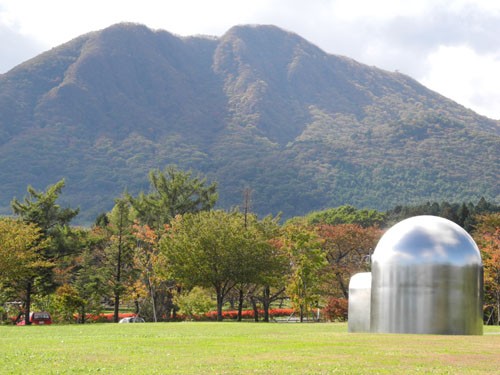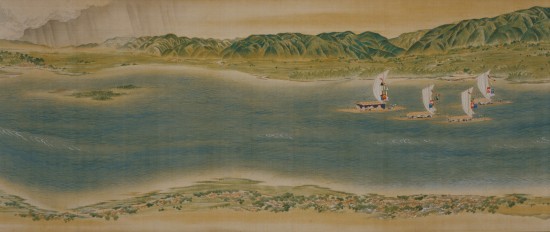From Hara Museum ARC, Gunma

Olafur Eliasson Sunspace for Shibukawa 2009
Shapes of the Seasons has started at Kankai Pavilion. This exhibition showcases works from the Hara Rokuro Collection that depict the changing forms and colors of nature, or are in some way connected with the seasons.
Over the ages, the Japanese have cultivated a keen sensitivity towards nature, ascribing poetic names to natural phenomena and expressing the subtle transitions between the seasons and the passage of time. Detailed observations of changes in phenomena such as the sky, winds, rivers, seas, and plants were essential for the ordering of everyday life. In all places and times, art has given form to those natural phenomena deeply connected with the lives of people. Such artworks are associated with a wide range of subject matter including annual events, the weather and astronomy, and a great many came to be embodied as decorative furnishings for the home.
This exhibition includes such superb examples of early modern painting as Maruyama Okyo’s Landscape of Yodo River (Part I and II) and Field with the moon and the subject called ‘Musashino’ (Part I) and Mori Tetsuzan’s A hundred cranes (Part II).

Maruyama Okyo, Landscape of Yodo River, hand scroll (detail), Edo period, 1765
This 16-meter long scroll painting shows the Yodo River as it flows from Fushimi in Kyoto to Tenmabashi in Osaka. The unique perspective by which the scenery unfolds on the top and lower banks, the use of the visual sense to express space, the details of the water surface in ultramarine blue and the accuracy that he achieved through the use of a sketch make this a deeply impressive work of art.
The section on display shows six boats passing Mount Tennozan and Mount Otokoyama, on which is drawn a pagoda of Iwashimizu Hachimangu Temple. Enjoy its details extend to changes in the color of the sky, the condition of the clouds and variations in the weather that correspond with the passage of time.
■ Featured works
Traditional Art
【Parts I and II】Maruyama Okyo, Landscape of Yodo River, Edo period, 1765
【Part I only】Field with the moon, the subject called “Musashino”, Edo period, 17th century/Kano school, Landscape with snowy mountains (part of paintings used for wallpaper and sliding doors at Nikko-in guest hall in Mi’idera temple), Momoyama-Edo period, 16th-17th century/Tier of boxes decorated with a squirrel and grape vine design in maki-e, Edo-Meiji period, 19th century and others
【Part II only】Kano Tan’yu, Dragon and Tiger, Edo period, 1671/Mori Tetsuzan, A hundred cranes, Edo period, 19th century/Pair of Satsuma ware sake bottles with portable maki-e case, Edo period, 19th century/Ruyi (Buddhist ritual implement) engraved with auspicious motifs, Qing dynasty, 19th century and others
Contemporary Art
【Parts I and II】David Smith, Tri-Construction, 1941/Anish Kapoor, Void, 1992/Kazz Sasaguchi, constellation, 2002/Noe Aoki, Tateyama, 2007 and others
【Part I only】Marta Pan, Sculpture 93, 1965/Aaron Fink, Orange, 1992
———————————————–
Shapes of the Seasons
Part I: October 28 (Fri.) – November 30 (Wed.), 2011
Part II: December 2 (Fri.), 2011 – January 4 (Wed.), 2012
Place: Hara Museum ARC Kankai Pavilion (traditional East Asian art)
Hours: 9:30 am – 4:30 pm *last entry 30 minutes before closing
Closed: Thursdays (except November 3 and December 29), January 1
*Subject to temporary closure during severe weather.
Admission: General (over 12) 1,000 yen; children (over 3) 500 yen; 10% discount for a group of 20 or more.
*Children must be accompanied by an adult
**Combination ticket for Hara Museum ARC and Ikaho Green Bokujo ranch: General 1,800 yen; Children 900 yen
Getting There: By train: Take the Joetsu Shinkansen to Takasaki, change to the Joestu Line, and disembark at Shibukawa. From Shibukawa, ARC is 10 minutes away by taxi or 15 minutes by bus (take the Ikaho Onsen bus to “Green Bokujo Mae”). By car: 8 kilometers (about 15 minutes) from the Kan-etsu Expressway Shibukawa Ikaho Interchange (in the direction of Ikaho Onsen).
<website> http://www.haramuseum.or.jp
<mobile site> http://mobile.haramuseum.or.jp
<Twitter> http://twitter.com/#!/HaraMuseumARC
